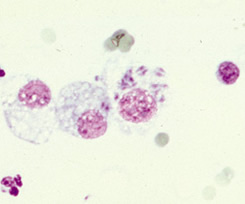| Toxoplasmosis | ||
Etiology Toxoplasmosis is the result of infection by Toxoplasma gondii, an obligate intracellular protozoan parasite in the phylum Apicomplexa. Transmission Carnivores and omnivores, including humans, can become infected when they eat raw or undercooked tissues containing tissue cysts or, occasionally, tachyzoites. Both herbivores and carnivores may ingest infective oocysts in food or water, inhale them in aerosols, or come into contact with contaminated soil. T gondii can cross the placenta in some species, particularly sheep, goats, humans and small rodents. Transmission in transfused blood or transplanted organs is possible but rare. Flies and cockroaches can Infections in Humans Clinical Signs In immunocompetent non-pregnant individuals, infection with T. gondii is usually asymptomatic. Approximately 10-20% of patients develop lymphadenitis or a mild, flulike syndrome characterized by fever, malaise, myalgia, headache, sore throat, lymphadenopathy and rash. Treatment Antibiotics may be used in pregnant women, immunocompromised patients with organ involvement, congenitally infected infants or individuals with ocular disease. Treatment of acute infections during pregnancy reduces the risk of infection in the fetus by approximately 50%. Healthy non-pregnant individuals may not be treated, as the infection is self-limiting and typically mild. Antibiotics cannot destroy tissue cysts and may not be able to eradicate actively dividing parasites. Infections in Animals Clinical Signs Most infections in animals are asymptomatic. Clinical toxoplasmosis is seen most often in sheep and goats. Occasional cases are also seen in young or immunosuppressed animals of other species. The most severe cases are usually seen in dogs less than 6 months old. Acute hepatitis, which is often fatal, may be associated with icterus, abdominal effusion, lethargy, fever, vomiting, diarrhea and signs of CNS or ocular involvement. Interstitial pneumonia, myocarditis, lymphadenopathy, tonsillitis, diarrhea and vomiting have also been reported. Ocular signs may include retinitis, uveitis and iridocyclitis.
Treatment Antibiotics and supportive therapy are used to treat clinical disease. |
||
| References: |




